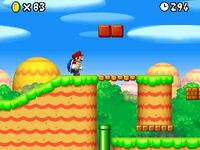Shell Mario
| Shell Mario | |
|---|---|
Shell Mario in Mario & Luigi: Bowser's Inside Story + Bowser Jr.'s Journey | |
| Applies to | Mario, Luigi |
| Item needed | Blue Shell |
| Power(s) given | Swim faster and more accurately, dodge attacks, slide through enemies |
| First appearance | New Super Mario Bros. (2006) |
| Latest appearance | Mario & Luigi: Bowser's Inside Story + Bowser Jr.'s Journey (2018) |
Shell Mario and Shell Luigi[1] (also known as Koopa Mario and Koopa Luigi[2]) are the forms of Mario and Luigi that they take by wearing a Blue Shell. The form debuted in New Super Mario Bros. It is the only power-up introduced in said game that does not appear in any of its sequels.
History[edit]
New Super Mario Bros.[edit]
Shell Mario is a form in New Super Mario Bros. It allows Mario to swim faster and with more accuracy, and gives him the Hammer Suit-like ability to dodge the attacks of enemies when he crouches. As long as he keeps ducking, he is safely protected from most enemies, but it will not protect him from Bob-omb explosions, Spiked Balls, hammers thrown by Hammer Bros. or Sledge Bros., boomerangs from the Boomerang Bros., and the volcanic debris from World 8-8. If Mario runs for a short time, or crouches while on a downward slope, he slides in the shell through a maneuver titled the shell dash, allowing Mario to defeat enemies such as Thwomps and Boos while along the way. However, the shell dash mechanics also make it almost impossible to Triple Jump, while Double Jumping becomes harder to perform, because Mario goes into the shell to slide shortly after he begins to run.
Mario & Luigi: Bowser's Inside Story / Mario & Luigi: Bowser's Inside Story + Bowser Jr.'s Journey[edit]
Shell Mario returns in Mario & Luigi: Bowser's Inside Story and its 3DS remake. The power-up is first acquired in the skies of Toad Town, where it was introduced by the Koopa Paratroopa Trio. Mario can turn into Shell Mario by striking shell blocks (which were spread around the Mushroom Kingdom when Mario and Luigi hit a giant version of them back in Toad Town). Luigi can then hit Mario using his hammer, and this makes Mario go into the shell, spinning straight in the direction he was facing. This can be used to hit blocks and platform-moving levers in areas which Mario and Luigi cannot directly go into, and hit enemies in the field to stun them. However, because the shell is so heavy, Mario is unable to jump in it. If he does, he loses the shell. It serves a similar purpose to Kooper and Koops's field abilities in the Paper Mario series.
Gallery[edit]
Shell Mario using a Spin Block in World 2-A of New Super Mario Bros.
Shell Mario on the world map of World 2 in New Super Mario Bros.
Names in other languages[edit]
Shell Mario[edit]
| Language | Name | Meaning | Notes |
|---|---|---|---|
| Japanese | コウラマリオ[?] Kōra Mario |
Shell Mario | |
| Chinese (simplified) | 龟壳马力欧[?] Guīké Mǎlì'ōu |
Shell Mario | |
| Chinese (traditional) | 龜殼瑪利歐[?] Guīké Mǎlì'ōu |
Shell Mario | |
| Dutch | Schild Mario[?] | Shield Mario | |
| French | Mario Koopa[?] | Koopa Mario | |
| German | Panzer-Mario[?] | Shell Mario | |
| Italian | Tarta Mario[?] | Turtle Mario; tarta is short for tartaruga ("turtle") | New Super Mario Bros. |
| Mario guscio[?] | Shell Mario | Bowser's Inside Story + Bowser Jr.'s Journey | |
| Korean | 등껍질마리오[?] Deungkkeopjil Mario |
Shell Mario | |
| Portuguese (NOE) | Mario Carapaça[?] | Shell Mario | |
| Spanish | Mario Koopa[?] | Koopa Mario |
Shell Luigi[edit]
| Language | Name | Meaning | Notes |
|---|---|---|---|
| Japanese | コウラルイージ[?] Kōra Ruīji |
Shell Luigi | |
| Chinese (simplified) | 龟壳路易吉[?] Guīké Lùyìjí |
Shell Luigi | |
| Chinese (traditional) | 龜殼路易吉[?] Guīké Lùyìjí |
Shell Luigi | |
| Dutch | Schild Luigi[?] | Shield Luigi | |
| French | Luigi Koopa[?] | Koopa Luigi | |
| German | Panzer-Luigi[?] | Shell Luigi | |
| Italian | Tarta Luigi[?] | Turtle Luigi; tarta is short for tartaruga ("turtle") | |
| Korean | 등껍질루이지[?] Deungkkeopjil Ru'iji |
Shell Luigi | |
| Portuguese (NOE) | Luigi Carapaça[?] | Shell Luigi | |
| Spanish | Luigi Koopa[?] | Koopa Luigi |
Notes[edit]
- In Super Mario 3D World and its Nintendo Switch port, the player can crouch while holding a Koopa Shell to shell dash with it similar to Shell Mario.
References[edit]
- ^ 2006. New Super Mario Bros. instruction booklet. Nintendo of America (American English). Page 24.
- ^ New Super Mario Bros. official website.







